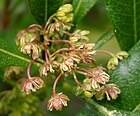Note: This is a project under development. The articles on this wiki are just being initiated and broadly incomplete. You can Help creating new pages.
Difference between revisions of "Dodonaea viscosa"
| Line 2: | Line 2: | ||
'''Dodonaea viscosa''' is a spreading evergreen shrub or small tree. Usually grows upto 1.5 - 5 metres tall. The short bole can be 15 - 25cm in diameter. | '''Dodonaea viscosa''' is a spreading evergreen shrub or small tree. Usually grows upto 1.5 - 5 metres tall. The short bole can be 15 - 25cm in diameter. | ||
==Uses== | ==Uses== | ||
| − | {{Uses|}}, {{Uses|}}, {{Uses|}}, {{Uses|}}, {{Uses|}}, {{Uses|}}, {{Uses|}}, {{Uses| | + | {{Uses|Rheumatism}}, {{Uses|Cold}}, {{Uses|Indigestion}}, {{Uses|Ulcers}}, {{Uses|Diarrhoea}}, {{Uses|Constipation}}, {{Uses|Dysmenorrhoea}}, {{Uses|Malaria}}. |
==Parts Used== | ==Parts Used== | ||
Revision as of 10:46, 29 April 2020
Dodonaea viscosa is a spreading evergreen shrub or small tree. Usually grows upto 1.5 - 5 metres tall. The short bole can be 15 - 25cm in diameter.
Contents
- 1 Uses
- 2 Parts Used
- 3 Chemical Composition
- 4 Common names
- 5 Properties
- 6 Habit
- 7 Identification
- 8 List of Ayurvedic medicine in which the herb is used
- 9 Where to get the saplings
- 10 Mode of Propagation
- 11 How to plant/cultivate
- 12 Commonly seen growing in areas
- 13 Photo Gallery
- 14 References
- 15 External Links
Uses
Rheumatism, Cold, Indigestion, Ulcers, Diarrhoea, Constipation, Dysmenorrhoea, Malaria.
Parts Used
Chemical Composition
Common names
| Language | Common name |
|---|---|
| Kannada | |
| Hindi | |
| Malayalam | |
| Tamil | |
| Telugu | |
| Marathi | |
| Gujarathi | |
| Punjabi | |
| Kashmiri | |
| Sanskrit | |
| English |
Properties
Reference: Dravya - Substance, Rasa - Taste, Guna - Qualities, Veerya - Potency, Vipaka - Post-digesion effect, Karma - Pharmacological activity, Prabhava - Therepeutics.
Dravya
Rasa
Guna
Veerya
Vipaka
Karma
Prabhava
Habit
Identification
Leaf
| Kind | Shape | Feature |
|---|---|---|
Flower
| Type | Size | Color and composition | Stamen | More information |
|---|---|---|---|---|
| {{{5}}} |
Fruit
| Type | Size | Mass | Appearance | Seeds | More information |
|---|---|---|---|---|---|
Other features
List of Ayurvedic medicine in which the herb is used
Where to get the saplings
Mode of Propagation
Seeds, Cuttings of half ripewood
How to plant/cultivate
A plant of the warm temperate to tropical zones, where it is found at elevations up to 1,600 metres. It grows best in areas where annual daytime temperatures are within the range 18 - 38°c, but can tolerate 7 - 45°c.[3]
Commonly seen growing in areas
Sandy soils, Rocky soils, Stony soils, Dry slopes.
Photo Gallery
References
- ↑ [Chemistry]
- ↑ [Morphology]
- ↑ Cultivation
Cite error: <ref> tag with name "Uses" defined in <references> is not used in prior text.
External Links
- Pages with reference errors
- Ayurvedic Herbs known to be helpful to treat Rheumatism
- Ayurvedic Herbs known to be helpful to treat Cold
- Ayurvedic Herbs known to be helpful to treat Indigestion
- Ayurvedic Herbs known to be helpful to treat Ulcers
- Ayurvedic Herbs known to be helpful to treat Diarrhoea
- Ayurvedic Herbs known to be helpful to treat Constipation
- Ayurvedic Herbs known to be helpful to treat Dysmenorrhoea
- Ayurvedic Herbs known to be helpful to treat Malaria
- Herbs with Leaves used in medicine
- Habit - Evergreen shrub
- Index of Plants which can be propagated by Seeds
- Index of Plants which can be propagated by Cuttings of half ripewood
- Herbs that are commonly seen in the region of Sandy soils
- Herbs that are commonly seen in the region of Rocky soils
- Herbs that are commonly seen in the region of Stony soils
- Herbs that are commonly seen in the region of Dry slopes
- Herbs
- Pages without herbs images



